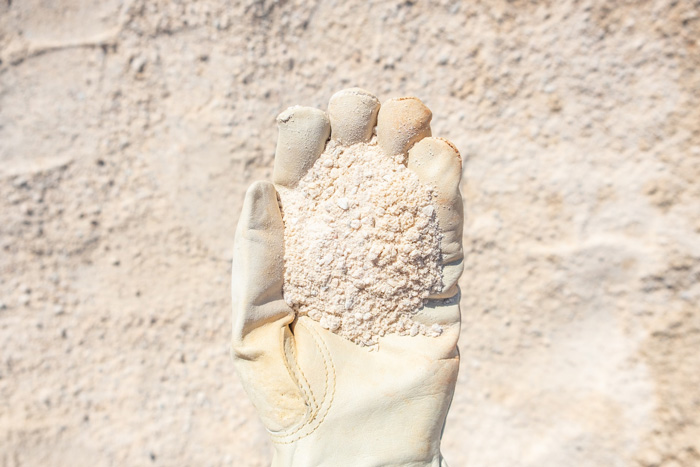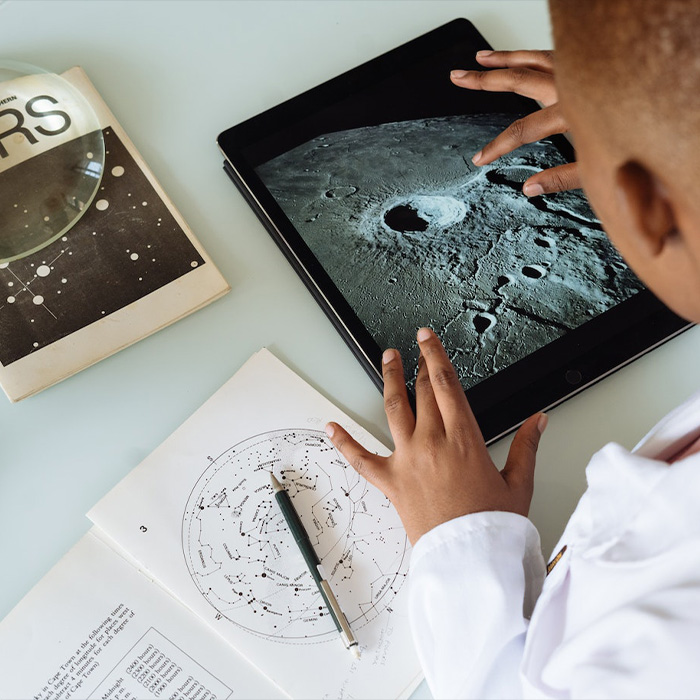Look up at the sky, what do you see? Stars most likely, but what about the Moon? To some, seeing the moon in the sky has become a stale sight for the eyes. When you see it every day, it becomes rather boring to look at. All the focus is stolen by the bright dots of stars, but don’t underestimate the Moon. There are some awesome facts about the Moon that you might not know. Sure, it’s in the sky, but this one fact about the moon is just that — one fact. There is plenty to learn about this cosmic body that rotates around the Earth!
Who’s rocky and big? No, not the protagonist of Rocky, but rather our one and only Moon. This lump of rock that brings in the joy of night every day is one of the coolest things in our sky. A lot of interesting facts about the Moon focus more on the scientific side about the Moon. After all, we humans like to explore things. We pushed ourselves so much that we even landed on it. But there are a lot of cool facts about the Moon that we can learn, based more on the creative side. The Moon is said to change emotions based on its phases and waves because of its pull. Our Moon is also as pretty as a picture; some photographers capture its beauty by taking stunning supermoon photos. Of course, there are also some strange facts about the Moon, but give it some slack — it’s our only natural satellite in the sky!
Now, you might just know the crumbs of the fun facts about the Moon that there is to learn. It’s just like Earth — interesting and deep. But why spend time looking for singular facts, when you can have it all here? With the list we created below, not only will you enhance your knowledge of our rocky friend in the sky, but you might also find some interesting talking points to share with others. If a fact piqued your interest, upvote it for others to see. But if you have something to add, be sure to leave a comment.
This post may include affiliate links.
 The Moon is moving approximately 3.8 cm away from our planet every year.
The Moon is moving approximately 3.8 cm away from our planet every year.
The Moon actually has its own time zone called Lunar Standard Time (LST).
A lunar year consists of 12 days. This may sound like a short year, but each lunar day consists of 29.5 Earth days, so a lunar year is very similar to its Earth equivalent.
 Shadows appear darker on the Moon than they do on Earth.
Shadows appear darker on the Moon than they do on Earth.
This is because there is very thin atmosphere on the Moon, so light fragments cannot be refracted to cast shadows that create much contrast.
The Moon has quakes too.
They're called moonquakes. They are caused by the gravitational influence of the Earth and last only a few minutes.
 Moon's surface temperatures reach boiling point.
Moon's surface temperatures reach boiling point.
Temperature can span from 123 degrees Celsius to -233 degrees Celsius.
A lunar eclipse saved Christopher Columbus from starvation.
On February 29, 1504, Columbus utilized a lunar eclipse to scare the local Arawak Indians on the island of Jamaica into providing food for him and his crew. His son Ferdinand claimed that when the Arawaks saw the eclipse, they ran hysterically and wailing from all directions to the ships carrying supplies.
There are important resources on the Moon.
These resources include hydrogen, which can be used to propel rockets; water ice, which can be split into hydrogen and oxygen for fuel and helium-3, a non-radioactive helium isotope that could potentially be used to provide nuclear energy in the future.
The Moon is a bit of a garbage site.
With so many NASA trips to the Moon, plenty of waste has been left behind. This includes lunar rovers, science equipment, golf balls, and even human feces.
While nations have signed peace treaties to prevent wars on Earth, many have joined the Outer Space Peace Treaty to keep the Moon from ever devolving into a war zone.
Many people still think that the Moon landing in 1969 was a hoax.
The skeptics claim that no stars can be seen in the background of the astronauts' images from the moon. Buzz Aldrin, the second astronaut to walk on the Moon, punched a conspiracy theorist in the face when he confronted him and called him a liar.
The giant-Impact hypothesis states that the moon was created when a rock the size of Mars slammed into Earth, shortly after the solar system began forming about 4.5 billion years ago.
Lunar research bases are soon to come.
“Although we are centuries off large numbers of people living on the Moon, it is possible we could soon have scientific bases there, similar to Antarctic research stations,” explained Robert Massey, the deputy executive director of the Royal Astronomical Society.
 The dark side of the moon is a myth.
The dark side of the moon is a myth.
In reality both sides of the Moon see the same amount of sunlight however only one face of the Moon is ever seen from Earth. This is because the Moon rotates around on its own axis in exactly the same time it takes to orbit the Earth. The side facing away from Earth has only been seen by the human eye from spacecraft.
The Moon is shrinking and that causes moonquakes.
Its diameter has reduced by more than 50 meters over the last several hundred million years. It starts getting wrinkles as it shrinks down, but the Moon’s surface is not flexible, so the shrinking causes “thrust faults” where one section of the crust gets pushed up over a neighboring part.
Astrophysicists estimate that the Moon is 4.5 billion years old.
The Moon may appear to be a perfect spherical orb, but in reality it is more like a lemon.
Without the Moon, the Earth would rotate much faster, resulting in 100 miles an hour winds and 8-hour days
 Gothic tales have been inspired by the mystery and eeriness of the full moon for centuries.
Gothic tales have been inspired by the mystery and eeriness of the full moon for centuries.
The first mention of a werewolf can be found in The Epic of Gilgamesh, written in 2100 B.C. The curse suggests that anyone bitten by this mythical creature will also become one and transform into a half-man, half-wolf beast on the night of a full moon.
John Heywood stated that the moon was made of green cheese.
On April fool's day in 2002, NASA said that astronomers have been able to confirm that the Moon is made of green cheese and even found its expiration date after which the Moon may go bad.
"Green cheese" is the translation of a Hebrew pun. Clear Hebrew text: YaRa:aKH GaVNooNi = gibbous moon Hebrew pun: YaRoK G'ViNaH = green cheese English: The moon is made of green cheese.
Actually, the Moon's surface is dark.
Although it seems extraordinarily bright when contrasted to the night sky, its reflectance is only slightly higher than that of cracked asphalt.
There is water on the moon.
This is in the form of ice trapped within dust and minerals on and under the surface. Comets are most likely responsible for bringing water to the Moon's surface.
Moon dust smells like gunpowder and no one knows why.
 Moon craters can unlock space history.
Moon craters can unlock space history.
Each crater, individually, can tell a story, both about the surface it impacted into and about the incoming meteor. Also, all the craters together can tell stories about the history of the surface and the history of solar system bombardment.
The moon's surface is covered with dead volcanoes, impact craters, and lava flows, some visible to the unaided stargazer.
Since the Moon has only a very thin atmosphere, a layer of dust — or a footprint — can sit undisturbed for centuries.
There are also no seasons on the Moon.
 The Moon appears to change its shape each night, because as it orbits the Earth, the Sun lights up different parts of its surface – so it’s just our view of the Moon that’s changing, not the Moon itself.
The Moon appears to change its shape each night, because as it orbits the Earth, the Sun lights up different parts of its surface – so it’s just our view of the Moon that’s changing, not the Moon itself.
Like Earth, the Moon has gravity.
The Moon’s gravity is weaker, only one sixth of the Earth’s gravity, in fact. That means you’d weigh much less if you were to stand on the Moon.
The Moon has only been walked on by 12 people.
Twelve of the 24 men who traveled from Earth to the Moon walked on its surface. The first, and most famous, was Neil Armstrong in 1969.
An African American woman, Katherine Johnson, calculated the trajectory and reentry coordinates of the Apollo 11 mission to the Moon. She played a pivotal role in ensuring the U.S. won the space race.
She was the pivotal role Would have happened with our Miss Katherine!!
 Many astronauts have reported hay fever-type symptoms after coming into contact with moon dust. Sneezing, an itchy throat, and sore eyes are the most common side effects.
Many astronauts have reported hay fever-type symptoms after coming into contact with moon dust. Sneezing, an itchy throat, and sore eyes are the most common side effects.
Nearly 81% of mental health professionals believe the full moon can make people ill.
The word “lunatic,” after all, stemmed from the idea that changes in mental state were related to lunar cycles.
The ancient Sumerians were the first civilization to use the Moon to form a calendar.
Each month on this calendar had 29 or 30 days, depending on whether or not the first day had a full moon. Regardless, there were always 12 months in a year.
 The Moon always shows Earth the same side.
The Moon always shows Earth the same side.
It rotates in synchrony with the Earth. Large, black plains that span the distances between the bright, ancient crustal mountains and the noticeable impact craters are what distinguish its near side.
The Moon and Earth exert a gravitational pull on each other. On Earth, the Moon's gravitational pull causes the oceans to bulge out on both sides of the moon. These bulges create high tides - it causes a tide of rock to rise and fall in the same way as it does with the water.
It takes 27.3 days for the Moon to travel all the way around the Earth and complete its orbit.
The first spacecraft to reach the Moon was Luna 1 in 1959.
This was a Soviet craft, which was launched from the USSR. It passed within 5995 km of the surface of the Moon before going into orbit around the Sun.
 The Moon has over 300,000 craters with a diameter of over 1 km that have been identified on its near-side.
The Moon has over 300,000 craters with a diameter of over 1 km that have been identified on its near-side.
There have been 78 movies made by Hollywood-based studios set on the Moon or that mention the Moon in the plot.
Stuart Roosa, an American astronaut, took 500 tree seeds to the Moon in 1971 before bringing them back to Earth.
These tree seedlings, such as sycamore, sweetgum, and redwood, have grown successfully and are still flourishing today. Many “Moon Trees” have gone global, with a loblolly pine gifted to the Emperor of Japan and a sweet gum planted in Brazil.
The side of the Moon that we don’t see was first photographed in 1959 by the Soviet Union and their Luna 3 module.
 After NASA deliberately crashed the Lunar Prospector module onto the lunar surface in 1999, geologist Dr. Eugene Shoemaker's ashes were the only ones to be scattered on the lunar surface.
After NASA deliberately crashed the Lunar Prospector module onto the lunar surface in 1999, geologist Dr. Eugene Shoemaker's ashes were the only ones to be scattered on the lunar surface.
The light created by a full moon polarizes in the Earth’s atmosphere, so dung beetles navigate better under a full moon.
Franz von Paula Gruithuisen claimed to have seen towns of little green men on the Moon through his telescope in the 19th century. He had lost his reputation, yet he was still respected enough to have a crater named after him.
The Moon is Earth's only natural satellite. It goes around the Earth at a distance of about 385,000 kilometers.
 Some ancient communities believed the moon was a bowl of fire, while others thought it was a mirror that reflected Earth's lands and seas.
Some ancient communities believed the moon was a bowl of fire, while others thought it was a mirror that reflected Earth's lands and seas.
The Moon is a dusty ball of rock, measuring 3,476km in diameter – that’s roughly a quarter of the size of Earth.
Moon seas, despite their name, are plains of solidified lava which appear dark on the Moon's disc.
 Early Greeks thought of the moon as the goddess Artemis.
Early Greeks thought of the moon as the goddess Artemis.
Where the Egyptians had thought of the moon as a man and the sun as a woman, the Greeks reversed that and thought of the moon as a woman.
Artemis = ancient Greek goddess, identified by the Romans with Diana, characterized as a virgin huntress associated with the moon, forests and childbirth. The word "rhythm" is probably connected with the goddess Artemis. Rhythm < Latin rhythmus R and D=>T) resh-oh-dalet-feh rodaf = hunter (D=>T) taf-alef-oh-mem ta'omim = twins taf-oh-mem tom = perfect innocence, virgin taf-mem-oo-saf tamoos = unblemished condition (Talmudic) taf-mem-oo-saf-heh t'moosah = animal on the point of death (Talmudic) I thought this was rather remarkable until I discovered that Artemis has a Semitic origin. What is rhythm / Artem[is] pronounced backwards? Symmetry/meter
American Indian Tribes gave names to each of the full moons to keep track of the passing year.
The names are associated with the entire month until the next full moon occurs. For example, in March, it is known as the Full Worm Moon because earthworms appear out of the soft ground for birds to eat. Since a lunar month averages 29 days, the dates of the moons change from year to year.
The Moon is the second densest satellite among those whose densities are known. Jupiter's moon Io is the first-densest.
 During eclipses, the moon, Earth and sun are in a straight line.
During eclipses, the moon, Earth and sun are in a straight line.
A lunar eclipse takes place when Earth is directly between the sun and the moon, casting Earth's shadow onto the moon's face. A lunar eclipse can occur only during a full moon.
During the 1950’s the USA considered detonating a nuclear bomb on the Moon.
The secret project was during the height cold war was known as “A Study of Lunar Research Flights” or “Project A119” and meant as a show of strength at a time they were lagging behind in the space race.
The largest crater discovered on the Moon is called the South Pole-Aitken basin - a whopping 2,500 km in diameter and around 8 km deep.
 The Roman author Lucian wrote the first-ever science-fiction novel set in space over two thousand years ago, so people have been dreaming of setting foot on the Moon for a very long time.
The Roman author Lucian wrote the first-ever science-fiction novel set in space over two thousand years ago, so people have been dreaming of setting foot on the Moon for a very long time.
The corals of the Great Barrier Reef will spawn in October, November, and December straight after a full moon.
The ancient Sumerians believed that the celestial bodies in the sky were related to one another.
The Moon (Nanna) was the father of Venus (the goddess Ianna) and the Sun (the god Utu).
 The Sun and the Moon are not the same size.
The Sun and the Moon are not the same size.
In fact, the Moon is 400 times smaller than the Sun, but also 400 times closer to Earth.
As the Moon travels, it rotates on its own axis, just like our planet.
It takes roughly the same amount of time for the Moon to make a full rotation as it does for it to complete its orbit. This means we only ever see around 60% of the Moon’s surface from Earth. The part that faces Earth is known as the ‘near side’ and the other, the ‘far side’.
The Moon is the fifth largest natural satellite in the Solar System.
At 3,475 km in diameter, the Moon is much smaller than the major moons of Jupiter and Saturn.
So far, approximately 2,200 samples of rock, dust, sand, pebbles, water, and other geological materials have been collected from the surface of the Moon by NASA.
 Over 2000 years ago, the Babylonian civilization became the first to conduct basic scientific studies of the Moon.
Over 2000 years ago, the Babylonian civilization became the first to conduct basic scientific studies of the Moon.

 Dark Mode
Dark Mode 

 No fees, cancel anytime
No fees, cancel anytime 












































































